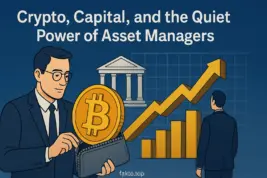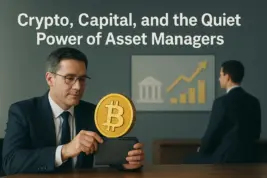How Asset Managers Are Scaling Crypto in the U.S.
Crypto, Capital, and the Quiet Power of Asset Managers
Let’s get one thing straight: crypto isn’t dying, it’s evolving. And if you’re still clinging to 2017 ideals of total decentralization, cold wallets in caves, and tax-free moonshots — you’re not wrong, you’re just late. The market has shifted. The players have changed. And yes, the big boys are here: Fidelity, BlackRock, and a dozen other asset managers who don’t ask for permission — they build infrastructure.

In 2025, the crypto landscape in the U.S. is no longer a fringe playground. It’s a regulated, tax-reported, ETF-integrated asset class. That’s not a betrayal of the original ethos — it’s a sign that crypto has matured. And if you’re smart, you’ll stop whining and start watching what Fidelity and BlackRock are actually doing. Because they’re not just buying Bitcoin — they’re shaping the rails for 2026, 2027, and beyond.
The Rise of Institutional Crypto Access
Fidelity didn’t just dip its toes into crypto — it built a bridge. With Fidelity crypto exposure now available through retirement accounts, brokerage platforms, and ETF wrappers, the firm has quietly onboarded thousands of traditional investors into digital assets. No seed phrases. No MetaMask. Just clean, compliant access.
BlackRock went bigger. Its spot bitcoin ETF strategy turned heads in Washington and Wall Street. Billions in inflows, daily liquidity, and tax reporting baked in. For many, it’s the first taste of crypto — and it’s served on a silver platter.
Crypto Tax Clarity: From Chaos to Compliance
Let’s talk taxes. Not because we love them, but because ignoring them is no longer an option. The IRS treats crypto as property. That means every trade, every staking reward, every NFT flip — it’s all reportable. And when you access crypto through Fidelity or BlackRock, you’re not dodging taxes — you’re streamlining them.
The shift from offshore wallets to regulated crypto investment vehicles isn’t just about safety — it’s about scalability. You want to build wealth in crypto? You need to play by the rules. And these firms are making it easier to do just that.

2026–2028: What Comes Next?
Let’s project forward. Here’s what we’re likely to see in the next three years — not as hype, but as grounded speculation based on current trends.
| Year | Institutional Trend | Retail Impact | Regulatory Shift |
|---|---|---|---|
| 2026 | Expansion of crypto ETFs to include staking rewards and multi-asset baskets | More passive investors enter via retirement accounts | IRS finalizes crypto staking tax framework |
| 2027 | Fidelity launches tokenized bond products on-chain | Retail gains access to yield-bearing digital assets | SEC introduces stablecoin classification rules |
| 2028 | BlackRock integrates DeFi protocols into ETF structures | Retail interacts with DeFi via brokerage platforms | Congress passes Digital Asset Infrastructure Act |
Questions Worth Asking
- Is crypto still “decentralized” if 80% of ETF volume flows through two firms?
- Do regulated access points reduce risk — or just shift it?
- Can retail investors still build wealth outside institutional rails?
- Will DeFi survive the ETF era — or be absorbed?
Recommendations for the Free-Minded Investor
You don’t have to love Fidelity or BlackRock. But you do need to understand them. If you’re building, trading, or educating — here’s what to keep in mind:

- Track institutional crypto inflows — they move markets.
- Understand crypto tax implications ETF — ignorance isn’t protection.
- Explore regulated crypto assets — not as a compromise, but as a tool.
- Balance your exposure — cold wallets still matter.
- Stay informed — asset managers don’t sleep, and neither should you.
Final Thought: Capitalism Isn’t the Enemy — It’s the Engine
Crypto was born from rebellion, but it thrives on infrastructure. The entry of asset managers isn’t a takeover — it’s a signal. A signal that crypto is no longer a niche, but a pillar of modern finance. You can fight it, ignore it, or embrace it. But you can’t pretend it’s not happening.
Fidelity and BlackRock aren’t here to kill crypto. They’re here to scale it. And if you’re smart, you’ll use their rails to build your own empire — on your terms.
From Rails to Real Power: Crypto’s Next Evolution
By 2026, the crypto market won’t be defined by hype cycles or meme coins — it’ll be shaped by infrastructure. Fidelity and BlackRock aren’t just offering access; they’re building rails. And those rails are becoming highways. Tokenized assets, on-chain compliance, and ETF-integrated DeFi aren’t buzzwords — they’re blueprints. The question isn’t “Will crypto survive?” It’s “Who will thrive?”
Retail investors are no longer sidelined. With crypto exposure via Fidelity and regulated crypto assets available through mainstream brokers, the average American can build a digital portfolio without touching a cold wallet. That’s not dilution — that’s distribution. And it’s happening fast.

DeFi Meets Wall Street: Collision or Convergence?
The old narrative painted DeFi as the anti-bank. But in 2027, we’ll likely see DeFi protocols integrated into ETF structures, offering yield, liquidity, and governance — all wrapped in compliance. BlackRock isn’t trying to kill DeFi. It’s trying to package it.
That’s not necessarily bad. If you’re a builder, it means more users. If you’re an investor, it means more stability. And if you’re a skeptic — well, you still have your cold wallet. But don’t ignore the shift: institutional crypto adoption is rewriting the rules.
Tax Season in the Age of ETFs
Let’s be real: crypto taxes used to be chaos. Manual spreadsheets, missing 1099s, and IRS letters that felt like riddles. But with crypto tax reporting for ETFs now standardized, the process is cleaner. Fidelity and BlackRock issue statements, brokers integrate with tax software, and investors file with confidence.
That doesn’t mean it’s simple — staking, airdrops, and cross-chain activity still require clarity. But the days of total confusion are fading. By 2028, we’ll likely see IRS crypto ETF rules</strong codified, with clear guidance on gains, losses, and digital income.
Freedom Isn’t Dead — It’s Scaling
There’s a myth that institutional crypto kills freedom. But freedom isn’t about avoiding regulation — it’s about choosing your path. You can still run a node, hold your keys, and trade on DEXs. But now, you can also build wealth through regulated crypto investment vehicles — without sacrificing security.

The future isn’t binary. It’s layered. And if you’re smart, you’ll use every layer — from ETFs to DeFi, from tax guides to tokenized bonds. Because crypto isn’t just a rebellion anymore. It’s a system. And systems scale.
2026–2028: Strategic Moves for Builders and Investors
- Monitor crypto ETF inflow trends — they signal market sentiment.
- Use crypto compliance checklists to stay audit-proof.
- Explore digital asset management tools — especially those built by asset managers.
- Balance exposure: mix custody solutions with self-sovereign wallets.
- Stay ahead of crypto regulation USA — it’s evolving fast.
What We’re Likely to See Next
By late 2026, expect Fidelity to launch yield-bearing crypto portfolios for retirement accounts. BlackRock may tokenize real estate and offer fractional ownership via blockchain. And the IRS? It’ll likely roll out a crypto audit risk matrix, flagging wallets and exchanges based on activity.
In 2027, we could see stablecoin-backed ETFs, giving investors exposure to digital dollars with interest-bearing mechanics. And by 2028, don’t be surprised if Wall Street crypto entry</strong becomes the norm — with every major bank offering digital asset services.
Final Word: Build, Don’t Beg
You don’t need permission to succeed in crypto. But you do need strategy. Fidelity and BlackRock aren’t your enemies — they’re part of the terrain. Learn their moves, use their rails, and build your own empire. Because in this market, freedom isn’t about isolation — it’s about integration.
Crypto is scaling. Capital is flowing. And the future? It’s yours to shape — one wallet, one ETF, one smart contract at a time.
Independent by Design, Unapologetically Free
We’re not affiliated with Fidelity, BlackRock, or any other financial institution, fund, exchange, or regulatory body. We don’t take sponsorships, we don’t run paid placements, and we don’t ask for permission to speak. fakto.top exists because we believe crypto deserves independent voices—voices that question, explore, and build without corporate oversight. Everything we publish reflects our own perspective, grounded in research, experience, and the freedom to say what we think matters.

We write for builders, skeptics, and everyday investors navigating the digital frontier. Sometimes that means praising infrastructure. Sometimes it means calling out contradictions. But it always means thinking critically. If we highlight Fidelity’s ETF strategy or BlackRock’s crypto inflows, it’s because they shape the market—not because we’re on their payroll. If we critique tax policy or regulatory overreach, it’s because we believe in financial autonomy—not because we’re pushing an agenda.
This is independent publishing in the age of digital capital. No strings. No gatekeepers. Just perspective, analysis, and the freedom to build your own conclusions. If that makes us unpopular in some circles—so be it. We’re not here to please. We’re here to inform.
Disclaimer / No Liability
All content on this website is provided for informational purposes only and does not constitute financial, investment, tax, or legal advice.
We are not financial advisors and assume no responsibility for any decisions you make.
Cryptocurrencies are highly volatile and risky. You may lose all invested capital.
Always do your own research (DYOR) and consult qualified professionals before making any financial or legal decisions.
We make no guarantees regarding the accuracy, completeness, or reliability of the information provided.
References to third-party services or projects do not imply endorsement.
By using this site, you agree that all actions are at your own risk and you release the site owners and authors from any liability.
